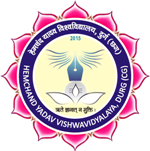Quick Links शैक्षणिक सत्र 2024-25 में स्नातक स्तर के पाठ्यक्रम में प्रवेश लेने वाले विद्यार्थी राष्ट्रीय शिक्षा नीति 2020 के पाठ्यक्रम के अंतर्गत प्रवेश लेंगे. RAJBHAVAN (CHHATTISGARH) विश्वविद्यालय में लोकपाल की नियुक्ति (डॉ. मिताश्री मित्रा) Alumni Registration Form Alumni Feedback Form Internal Complaints Committee ST/SC Cell IQAC Cell Equal Opportunity Cell Registration form for NEP Private 1st Sem. Students (Session 2025-26) Supplementary exam Form 2025 Admission Form (Session 2025-26) Admit Card:- Semester Exam (Non NEP) May-June 2025 Admit card:- Ph.D. Course Work Exam. 2024-25 Digital learning platform - PRSU Admit Card annual exam 2025 E-Samadhaan Portal Annual Exam Form 2025 Admit Card 2nd Sem. NEP Exam. May-June 2025 Syllabus (NEP 2020) Session 2024-25 NEP NEP Syllabus 2020 Enrollment Form (NEP) 2024-25 Enrollment Form for others 2024-25 Admit card:- Supplementary Exam 2025 Samarth Portal लोकपाल के समक्ष शिकायत हेतु आवेदन फॉर्म Creatives on Voter Awareness Teacher/Evaluator Registration Viksit Bharat@2047 Fight against Corona Voters services portal Online Migration/Degree Application Form Online "Eligibility Form " "पात्रता प्रमाण हेतु ऑनलाइन आवेदन फॉर्म" ACADEMIC BANK OF CREDIT (ABC) CERTIFICATE-COURSE-26-08-2022 Prevention of Caste Based Discrimination in Higher Education Online Study Material National Education Policy-2020 TEN DAYS ONLINE PhD COURSE WORK WORKSHOP 21-30 APRIL 2021 Teachers Day-2020 10 Days Faculty Development Program Affiliated Colleges Courses & Seats Syllabus
College Notifications Results :- Annual/Semester Exam College Login: Marks Entry/Download Academic Calendar Exam Centres Time Table Student Union Events/Seminars/Workshops Sports University Recruitment College Recruitment Proposed Campus Download National Academic Depository (NAD) University News /Press Release Anti Ragging RTI ActAbout Durg City
General
Durg district is one of the densely populated districts of the Chhattisgarh state of India. On the basis of climate & topography the Chhattisgarh state is divided into 3 agro climatic zones. The Bastar Plateau comprises of Bastar, Dantewada, Beejapur & Narayanpur districts and a part of Kanker (excluding Charama, Narharpur & Kanker Blocks). Northern parts of the state comes under “Northern Hilly Region” which comprises of Sarguja, Koriya & Jashpur Districts. Bilaspur, Raipur, Janjgeer-Champa, Raigarh, Rajnandgaon, Kawardha, Durg, Mahasamund, Dhamtari, Korba and parts of Kanker come under “Plains of Chhattisgarh”. Durg district is situated in the southern part of the rich Chhattisgarh plain.
-
Area of District Durg is 2238.36 Sq. Km.
-
District lies between 20°54′ and 21°32′ north lattitude & 81°10′ and 81°36′ east longitude.
-
District is 317 meters above mean sea level.
-
As per Census 2011 (provisional), the population of the district is 17,21,726. In which 6,17,184 is rural population and 11,04,542 is urban population.
-
The district is bounded by Bemetara district in the north, Rajnandgaon district in the west, Balod district in the south and Raipur and Dhamtri district in the east.
-
Durg district is situated on the Howrah-Mumbai main line of south-eastern railway. National Highway No. 6 also passes through the district.
Rivers
The general slope of the district is towards the north-east in which direction the major streams of the district flow.
Sheonath
Sheonath is main river of District Durg. Shivnath river is tributary of Mahanadi river. Shivnath river originates from Mountain at height of 625 meter at Panabaras situated in south western parts of Rajnandgaon and flows towards north east direction. Shivnath River measures length about 345 KM. City Durg is situated on east bank of Shivnath River. It flows towards north east passing through Khujji, Rajnandgaon, Durg, Dhasmha and Nandghat and joins (meet) Mahanadi near Shivari Narayan of Bilaspur District.
Kharun
Kharun river flows in eastern parts of the district starting from Petechua in Balod District. This river flows towards north and joins (meet) Shivnath river at Somnath. This river determines the boundary of Raipur and Durg district. The length of this river is about 120 KM.
Mineral Resources
This district has high quality rich deposits of limestone. The quarrying of limestone is ongoing at Nandini, Semariya, Khundani, Pithaura, Sahgaon, Deurjhaal, Ahiwara, Achcholi, Matragota, Ghotwani and Medesara. Limestone thus derived is utilized mainly by ACC for cement production and BSP for steel production.
Climate
Climate of the district is of tropical type. Summer is a little bit hotter. Rise of temperature begins from the month of March to May. May is hottest amongst other. Durg district’s annual average rainfall is 1052 MM. During the year, most rainfall occurs during the monsoon months June to September. July is the month of highest rainfall.

 Download App
Download App